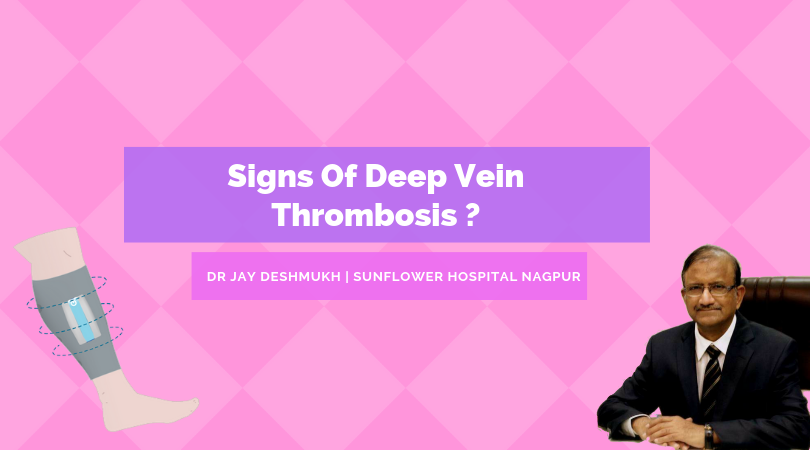sunflower hospital Nagpur:- Deep vein thrombosis is a blood clot that forms inside a vein. This is usually deep inside the leg. About more than 50 lac individuals get this in India and many die due to it. Many a time the clot from the leg may get dislodged from the vein and flow up and get lodged in the lungs. This may lead to various symptoms or even death. Prevention, early diagnosis and prompt treatment are of utmost importance.
sunflower hospital Nagpur:-
What are the major symptoms of DVT?
- About half of the individuals may not have any symptoms. There could just be swelling, pain or redness at the calf area of the leg. There might be local warmth at the calf or thigh muscle. Mild swelling on the feet can be visible.
What is pulmonary embolism?
- There is a clot that moves from the legs and gets lodged in the lungs. This blocks the blood supply to the lungs. This may result in severe cough, breathing difficulties, chest pain and spitting of blood. This may lead to a faster heart rate and low blood pressure.
What causes blood to clot in the deep veins of the calf muscles?
- Disorders that damage the inner lining of veins, stasis of blood, excess oestrogen, malignancy at any site in the body and certain genetic disorders can cause deep vein thrombosis.
Who are at risk of getting deep vein thrombosis?
- Those who have cancer, had recent childbirth, have had surgery, are on extended periods of bed rest, are older, smokers, are overweight or obese sit for long times like on a long aeroplane flight are particularly at risk. Those who have their legs or thighs plastered are also at an increased risk.
What about pregnancy and deep vein thrombosis?
- Women are more likely to get deep vein thrombosis in pregnancy or within 4 to 6 weeks after delivering a child. The pressure of the gravid uterus can slow the flow of blood in the veins going up from the feet upwards to the heart and lead to thrombosis.
What about hormone therapy?
- Birth control pills and some treatments for postmenopausal women can also increase the risk of thrombosis in the veins of legs.
What about prolonged sitting?
- The economic class syndrome is well known. If you sit in a cramped seat for more than 4 hours, then the risk of deep vein thrombosis gets doubled. It doesn’t matter if you go by car, bus, air or train. If you are in a cramped seat and you don’t move, the chances of deep vein thrombosis increase.
What is the best way to diagnose deep vein thrombosis?
- sunflower hospital Nagpur:- Besides the typical history and clinical examination, an ultrasound of the vein helps. This sonogram of the vein of the leg is very cost effective and carries no risk including radiation. A blood test is known as d dimmer also helps.
What are blood thinners?
- These are orally administered blood thinners like Coumadin or Warfarin or the newer Dabigatran, Rivaroxaban, Apixaban and Edoxaban. They act by different mechanisms. They don’t break the existing clots but they prevent new clot formation. They will give your body adequate time to dissolve the clots on its own. Some are available in injection forms like the old and new heparins.
Are there any side effects of these blood thinner?
- sunflower hospital Nagpur:- These patients require very close observation and adequate education. The drugs can lead to dangerous internal bleeding. The skin can turn purple or red. The urine or stools can contain blood. Good communication with your treating doctor is important.
What are vena cava filters?
- If the anti-clotting drugs are not working or there are side effects, your doctor may recommend a filter in your long and big vein, the vena cava. The filters prevent blood clots from reaching the lungs, though they do not prevent blood clot formation. They can prevent dangerous pulmonary embolism.
What are thrombolytic drugs?
- Drugs that burst the blood clots are thrombolytic drugs. They are given in a hospital setting. The risk of hemorrhagic complications is likely to increase with these drugs.
What are the travel tips to prevent deep vein thrombosis?
- Avoid tight clothing and drink plenty of water. Get up and walk at least every couple of hours. Try clenching and releasing your calf muscles every hour and move your thighs and toes.
- What are compression stockings? They prevent thrombosis, swelling and stasis of blood in the calf muscles. They may prevent the sequela of deep vein thrombosis. You need to have the correct size with the correct compression.
Unexpected, sad and catastrophic events after any major surgery or after delivering a child are not uncommon. Individuals with cancer and those with prolonged bed rest are at increased risk. Proper post-operative rehabilitation, prophylactic anti-clotting drugs after surgery and delivery in selected high-risk individuals is important. sunflower hospital Nagpur
Author: Dr Jay Deshmukh
M.B.B.S., M.C.P.S., F.C.P.S., M.N.A.M.S., MD
(Internal Medicine – Bombay and New Delhi)
Chief Physician and Director, Sunflower Hospital, Nagpur


